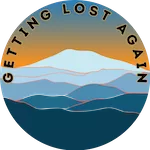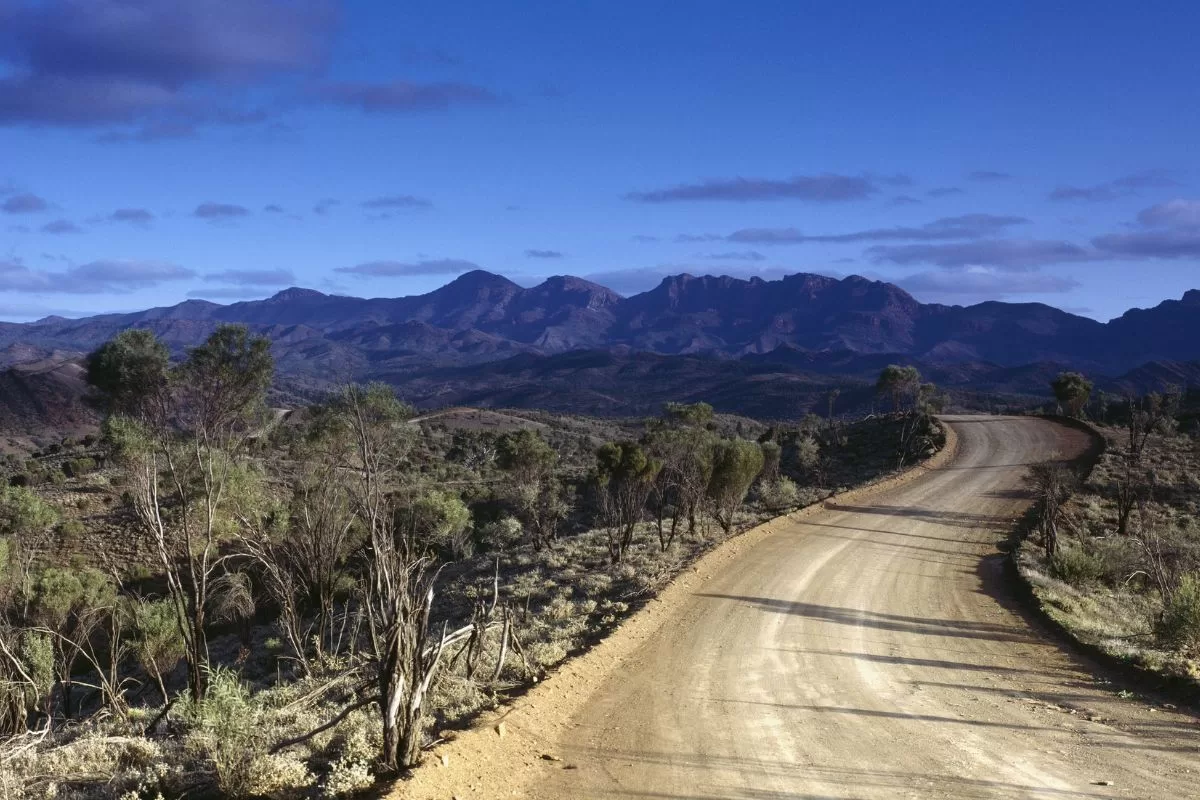
Essential Guide To Exploring The Flinders Ranges And Outback
The Flinders Ranges is in the heart of South Australia’s outback and a place we had always thought we would take tonnes of time to explore. BUT, I’m going to make a big call and say that the Ikara-Flinders Ranges National Park may be on the list of my all-time favourite places in Australia.
Usually, I’m a coastal gal, however, the beauty of the rugged and rocky mountain ranges, and the vast diversity of the flora and fauna had me mesmerised from the moment we arrived.
I’d always thought we’d need at least a week to make it worthwhile. Turns out I was wrong – a long weekend is the perfect chance to get an outback fix that’ll leave you itching to come back and explore some more. Don’t get me wrong, it was an epic road journey from Melbourne to the Flinders Ranges. Was it worth it for only a few nights? Definitely!
From hitting the hiking trails to catching an incredible sunset to exploring the 4WD tracks, there are plenty of things to do in the Flinders Ranges. If you’re considering a road trip up to this spectacular region in South Australia, this guide will help you plan your perfect trip to the Ikara-Flinders Ranges National Park.
What Are The Ikara-Flinders Ranges?
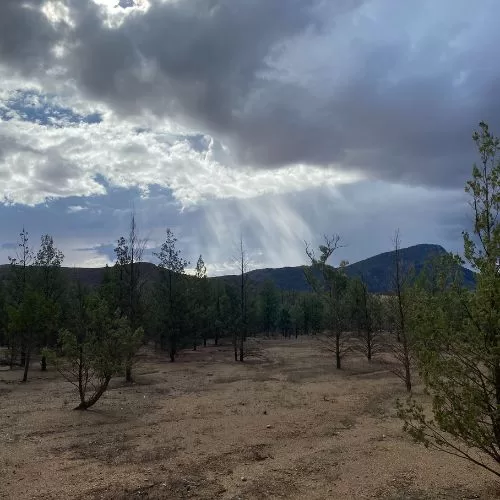
Ancient and rugged mountain landscapes, peaceful tree-lined gorges and a seasonal wealth of wildlife. The sense of space unique to the semi-arid zone combine to make Ikara-Flinders Ranges National Park one of South Australia’s iconic destinations.
The Ikara-Flinders Ranges National Park covers 95,000 hectares of the Central Flinders Ranges region. It includes the Heysen Range, Brachina and Bunyeroo gorges and the vast amphitheatre of mountains that is Ikara Wilpena Pound. It’s one of the oldest landscapes in the entire country, having formed over millions of years. For this reason, it’s an important geological area and attracts those interested in admiring some of the ancient rock formations.
For this reason, it draws thousands of visitors every year wanting to experience the native wildlife, rich cultural heritage, impressive geological features, camping opportunities and a range of activities including bushwalking, four-wheel driving, birdwatching, photography and mountain biking.
Check Out our Video on the whole Flinders Ranges Experience
Check out this video of our whole out-and-back experience, during which we explored the Flinders Ranges and Willow Springs and tried to get back to Melbourne on dirt roads only!
Best Time To Visit The Flinders Ranges
Summer – December to February

Between the months of December to February, the Ikara-Flinders Ranges average temperature often has highs of between 33-34 degrees Celsius and lows of between 17-19 degrees Celsius. Due to these high temperatures and the unbearable heat, multiple walking trails within the Flinders Ranges are closed during this time of the year. Making this one of the least recommended times to visit.
Autumn – March to May
Autumn is a popular time of the year to visit the Flinders Ranges. From the months of March to May, the Ikara-Flinders Ranges have temperatures ranging from highs of 21-31 degrees Celsius and lows of 8-16 degrees Celsius. The landscape is breathtaking with colours ranging from oranges through to the deep reds and browns.
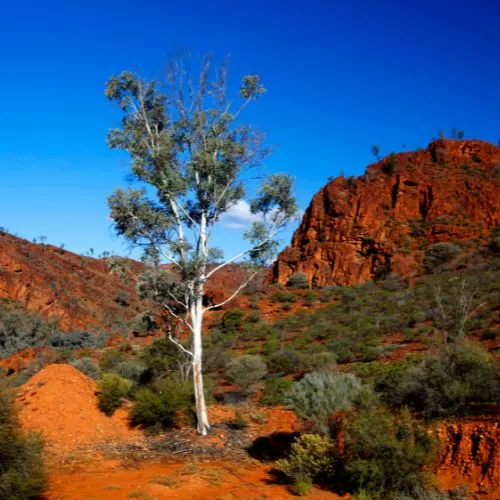
Winter – June to August

The temperatures during the Winter months range from 17-18 degrees Celsius. This makes visiting between the months of June and August the ideal time for trekking and exploration.
With a higher likelihood of rain, the creeks and waterbeds have a chance of being full and attracting wildlife. The abundance of wildlife includes species such as galahs, western grey kangaroos, emus and dingoes. Additionally, the sunrises and sunsets are spectacular! The skies are coloured with hues of pinks, reds and yellows. However, mornings and nights can be very cold, with temperatures dropping to around 3 degrees Celsius, making for a perfect cosy evening.
Spring – September to November
Spring is the best time to visit the Flinders Ranges. Between September and November, the Ikara-Flinders Ranges are covered in wildflowers. Thanks to the rain from the Winter season, the landscape is scattered with bursts of colour amid the native plants and trees. The average temperature ranges between highs of 22-30 degrees Celsius and lows of 7-14 degrees Celsius. If you are lucky, you might catch a glimpse of a Mama Emu with her flock of chicks, flocks of migrating birds and parrots a plenty!
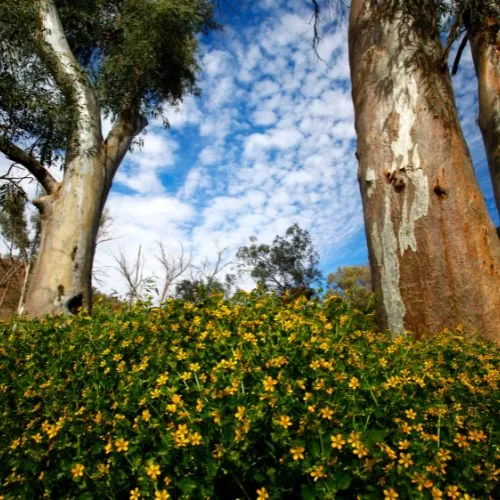
Top 5 Reasons to Visit The Flinders Ranges
1. The Flinders Ranges is the Most Accessible Outback Region in Australia
With excellent infrastructure and loads to see and do, the Flinders Ranges are a must-visit destination in South Australia. Situated in the central Flinders Ranges, approximately 450 kilometres north of Adelaide, 1138 kilometres from Melbourne and 1557 kilometres from Sydney. The Ikara-Flinders Ranges National Park is full of treasures, hikes, wildlife and history.

2. The Ancient Rocky Landscapes are Geographical Marvels
The gorges, Wilpena Pound and further north the forms of uranium in some rocks are some amazing sights. The natural rock formation of Ikara (Wilpena Pound) is a spectacular landform and a must-see when visiting the central Flinders Ranges. It can be appreciated along one of the many well-established bushwalking trails. The higher walls of the Wilpena Pound are quartzite, a rock very resistant to weathering. The landmark of Wilpena Pound is a remnant valley floor from an ancient range of mountains that have been eroding away over millions of years.

3. The Best 4WD Driving in the Country
In the Flinders Ranger the 4WD and off-road is a choose-your-own adventure with anything from easy to extremely challenging, half-day to multi-day journeys. A four-wheel drive is not a necessity to get around in Flinders Ranges, however, experiencing it in a four-wheel drive can be an incredibly exhilarating experience. You can join a four-wheel drive tour with Rawnsley Park Station, Flinders Experience Tours or Wilpena Pound Resort. Alternatively, if you have come in a 4×4 and you want to experience a self-drive 4WD tour, we highly recommend Skytrek Willow Springs Station. When we visited the Flinders Ranges, we thoroughly enjoyed our day on Skytrek 4WD track.

4. Hiking – Some of the Most Pleasurable Outback Walking in the Country
There’s loads of wildlife and the best way to experience the local critters is by taking a hike, short or long. The Heysen trail starts here at the Flinders Ranges and stretches 1,200km to Cape Jervis in the south of South Australia. The Flinders Ranges has a great mix of trails, ranging from easy walks to strenuous hiking.
Standing as an ancient natural monument crafted by millions of years of geological activity, the Flinders Ranges offers some of Australia’s most magnificent scenery. Offering many walking and hiking trails, the most famous being the incredible Heysen Trail. Additionally, you can explore the ancient rocks within Wilpena Pound or walk the Alligator Gorge. Whatever you choose to do, there are options for all walkers and hikers.
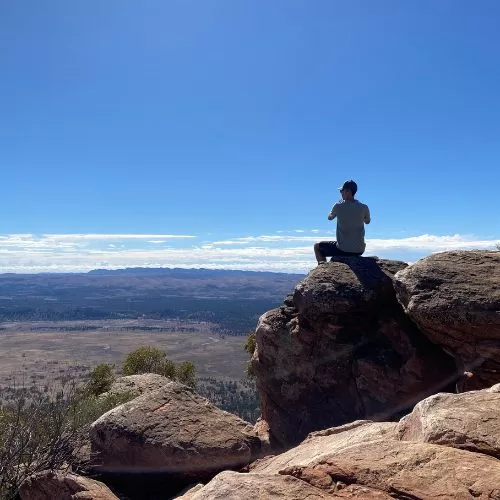
5. It’s Historically Rich!
When visiting the Flinders Ranges, there are quite a few opportunities to learn about the Traditional Owners and their culture. If you are staying at Wilpena Pound Resort, we highly recommend going to the daily Welcome to Country talk on the front lawn of the resort. It was powerfully moving and informative. If you are not staying at Wilpena Pound, or cannot make the Welcome to Country, you can also head to Arkaroo Rock to admire some incredible rock art.

Things To Do In The Flinders Ranges
1. Walking & Hiking
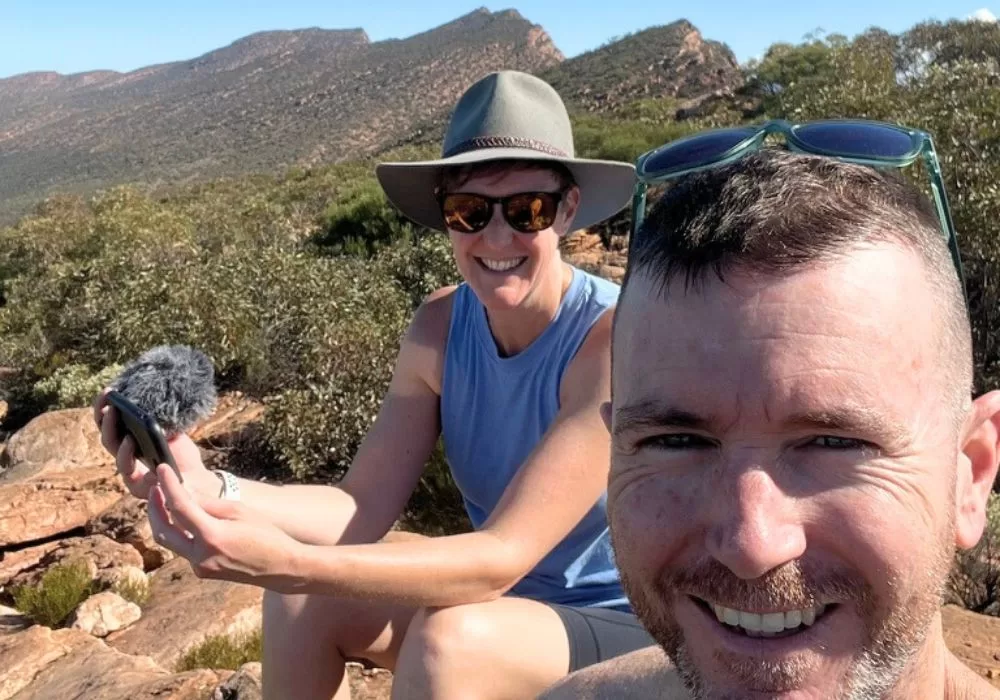
The number one activity to do in the Flinders Ranges is without a doubt hiking. There are 4 walks and 14 hikes within the Flinders Ranges National Park. With a variety of trails to suit a diverse range of fitness levels, from easy strolls to tough scrambles up towering peaks. Regardless of how much time you spend in the national park, make sure that you head out on at least one hike. Many of the trails begin from Wilpena Pound Resort, making it a convenient base if you’re planning on doing some walks.
For a relatively easy stroll, try the Wangara Lookout, or if you’re up for a tough climb that’s rewarded with incredible views, do Mt Ohlssen Bagge. We climbed Mt Ohlssen Bagge during our visit to the Flinders Rangers. It was a breathtaking walk, with a lung-splattering climb, to be rewarded with a spectacular view. Alternatively, outside of Wilpena Pound, you’ll find Arkaroo Rock, an easier walk that will take you to some rock art. Additionally, you can try the great day hike up to Rawnsley Bluff.
2. 4WD Self-Drive & Tours
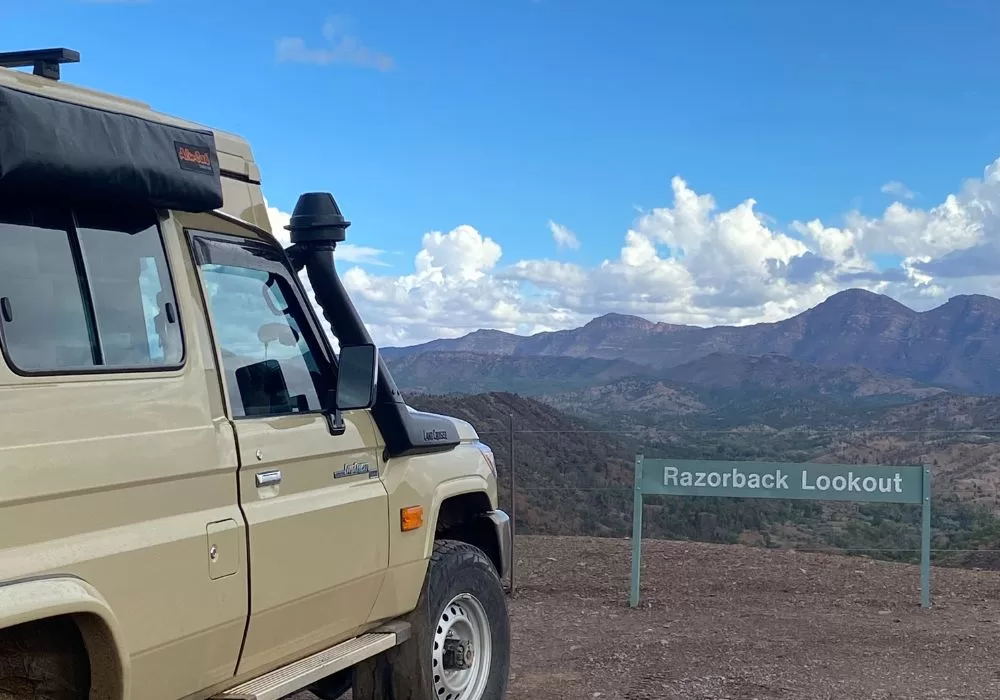
Some incredible drives through the Flinders Ranges National Park offer exceptional scenery. The Brachina Gorge Road is perhaps the most well-known of these drives. The unsealed road connects the Flinders Ranges Way with the Outback Highway straight across the national park through some of the most fascinating geological formations in the region. The road is a bit rough and recommended for 4WD, although the section from the Flinders Ranges Way in the east to Aroona Valley Road intersection is doable with a 2WD.
We had a brilliant day driving the Skytrek at Willow Springs Station. One of Australia’s most popular and most diverse 4WD journeys to be experienced. The history and information set up on this self-drive 4WD adventure is epic.
The track must be started no later than 10:30 am to enjoy the magnificent seven-hour trek. And when they say 7 hours … they mean 7 hours. Set on Willow Springs Station, their 70,000-acre sheep property, SKYTREK is an 80km, Self-Drive off-road adventure.
The Skytrek takes you through majestic river-red gum-lined creeks, groves of native pines and black oak, over blue bush plains, through rugged mountain valleys and ascends and descends over multiple mountain ranges. Carmel, Brendan and Michelle have put together an amazing self-guiding map that points out all the unique features of their property. We would recommend heading on this self-drive tour if you have your own 4WD vehicle.
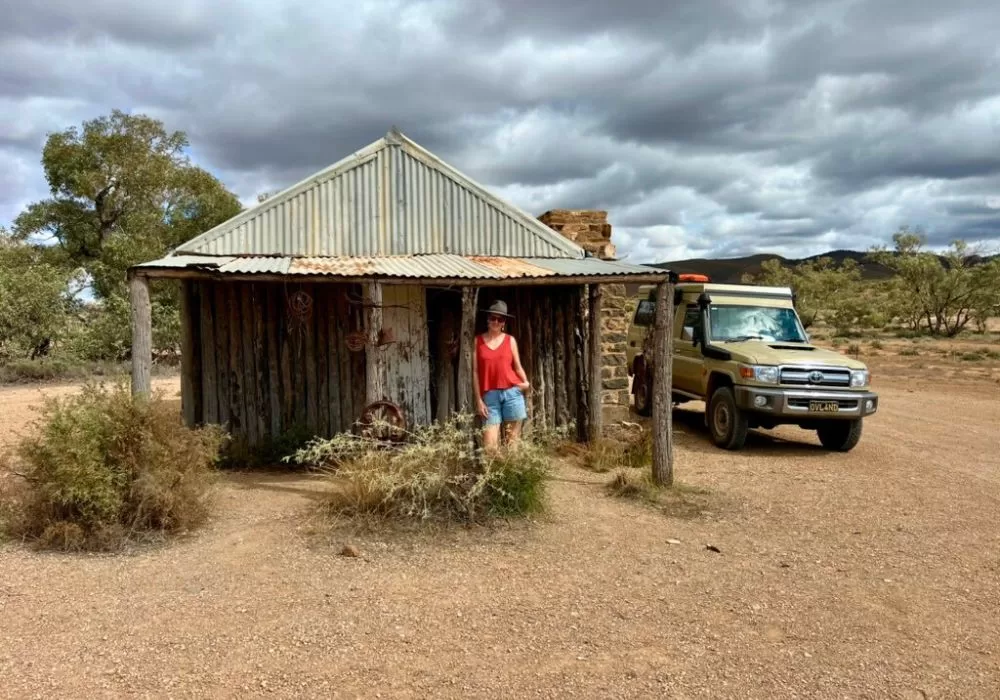
Want to know more about the SKYTREK self-drive tour? Read all about our 4WD Self-Drive SKYTREK adventure at Willow Springs Station
3. Step Back in Time at Brachina Gorge Geological Trail
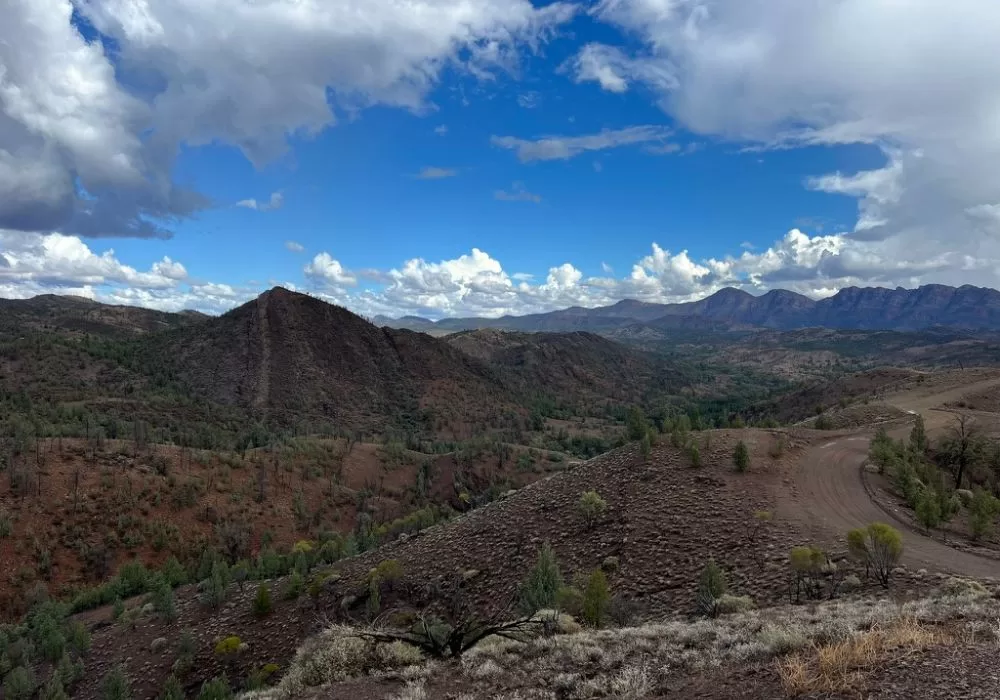
Yellow Footed Rock Wallaby – Brachina Gorge Geological Trail
There are some incredible drives through the park that offer outstanding scenery. Brachina Gorge is one of the Flinders Ranges National Park’s most popular and spectacular tourist attractions. The gorge is an important refuge for the Yellow Footed Rock Wallaby as well as many species of birds and reptiles.
Brachina Gorge Geological Trail is a 20km drive that takes you along an unsealed road connecting the Flinders Ranges Way with the Outback Highway. The trail takes you straight across the national park through some of the most fascinating geological formations in the region. Trail signage provides an insight into past climates, the formation of the ranges and the evolution of early life forms.
Why is Brachina Gorge so significant?
The Brachina Gorge trail showcases an impressive geological record from the geological time period between about 800 million and 500 million years ago. Essentially, the trail offers visitors an insight into 130 million years of Earth’s history. The gorge’s sedimentary layers are considered one of the best-exposed sites detailing the planet’s evolution. In fact, the importance of the Brachina Gorge’s geological and paleontological merit is so important that the trail has been included in the World Heritage Nomination bid for the Flinders Rangers.
When we drove the Brachina Gorge Trail we hit a sudden and quick downpour that rapidly filled the empty creeks, creating exciting and thrilling river crossings that we had not expected to be a part of the drive’s adventure. It added a whole new level of enjoyment to an already spectacular drive.
There is another unsealed road, heading off the Flinders Ranges Way to the Bunyeroo Gorge walking trail, before connecting back onto the Brachina Gorge Road. On Bunyeroo Road you’ll find a few incredible lookouts, including Bunyeroo Valley Lookout and Razorback Lookout both of which offer some of the best panoramic views in the park.
4. Enjoy Nature & the Native Wildlife

Wildlife-wise, yellow-footed rock wallabies, red kangaroos and western grey kangaroos can all be found in Flinders Ranges. The area is also home to numerous bird and reptile species, including the grey-fronted honeyeater, the wedge-tailed eagle and the Lake Eyre dragon.
So, if you’re looking for somewhere to see some of the iconic Australian wildlife species amidst picturesque and rugged scenery, look no further than Flinders Ranges National Park in South Australia.
As you explore the park you’ll find that there are plenty of kangaroos around. In fact you’ll likely see them every day that you’re in the park, or even in your campground. On that note, make sure that you drive carefully during early morning or at dusk, as they hop onto the road without any warning. Additionally, another wildlife encounter you need to be careful of while driving is with wedge-tailed eagles. These beautiful big birds can often be seen feasting on prey on the side of road, and unfortunately, it’s because of this that most are killed. So … slow down and be careful driving near them as they take off very slowly.

The most sought-after animal to be found in the Flinders Ranges is the yellow-footed rock wallaby. These unusual stripe-tailed wallabies are commonly found around Wilpena Pound and Brachina Gorge.
Typically you find them on the rock faces in the early morning and late afternoon. We were lucky enough to spot a couple of keen photographers stopping and pointing their cameras up at a rock face whilst we were heading through the Brachina Gorge Trail. We pulled up alongside them and were rewarded with a mob of yellow-footed rock wallabies enjoying the last light up on the rock face. You have to be quick and quiet though – they are easily spooked and because they are so well camouflaged once they start moving …. it’s hard to find them again!

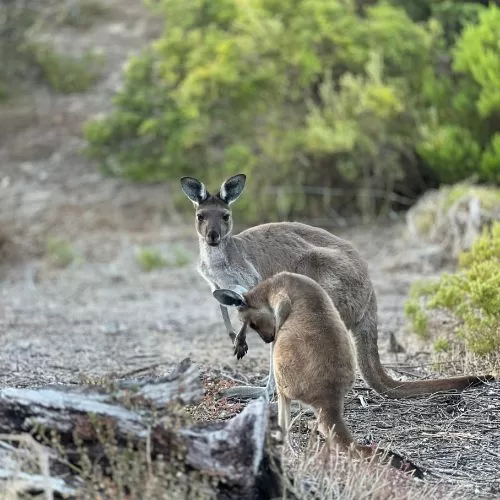
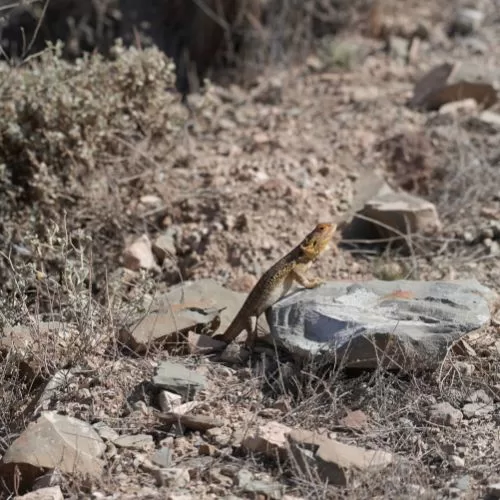
5. Watch the Sunrise & the Sunset
The distinct hues of the ranges and the outback landscape are at their best during Golden Hour, either sunrise or sunset. No visit to the Ikara-Flinders Ranges National Park would be complete without making the effort to head out to at least one sunset or sunrise. The park offers plenty of lookouts and viewpoints from where you can get a great vantage point over different parts of the Flinders Ranges.
In search of our own panoramic view of the Flinders Ranges, we headed for Stokes Hill. This hilltop lookout offers 360-degree views, with mountains as far as the eye can see. It’s a truly breathtaking view and made special in the soft light of sunset. Be warned – you will most definitely not be the only people up there! This is a popular spot for sunset watching and cars will be parked all around the summit at the top of Stokes Hill. If that doesn’t bother you – head on up and witness the magnificence of the sun setting across the Flinders Ranges.
Another sunset and sunrise spot to check is Razorback Lookout on the unsealed Bunyeroo Road. Alternatively, if you’re staying at Wilpena Pound Resort, there happens to be a fantastic sunset and sunrise spot just a few hundred metres from the campground. It’s a small hill just behind the unpowered section and is an unofficial spot. However, it offers incredible views of St Mary’s Peak and the Pound Wall.

6. Camp Under The Stars
Once the sun has gone down, star gazing is another popular thing to do in the Flinders Ranges. This is due to the fact that there is minimal light pollution. Regardless of whether you’re into astronomy or not, the beauty of the night sky when you are in the outback is phenomenal! You can head out to a lookout if you’re wanting to capture the night sky with little interference. Alternatively, you can simply camp for the night under the stars.
There are plenty of camping choices, such as the popular Wilpena Pound Resort Campground or you can book into one of the more remote camps of the SA Parks campgrounds like Aroona Campground. Camping is definitely one of the best ways to really appreciate the region and it’s perfectly set up for everything from caravans to tents. We stayed at Wiplena Pound Resort Campground. The campground is huge and can accommodate hundreds of visitors. But if you are in a tent or a 4WD camper like us, then heading to the top of the campground, meaning a bit of a walk to the ablutions, then you are more likely to find a bit more peace and quiet away from the crowds.

Regardless of the amount of time you have to take in the beauty of the Flinders Ranges, it is definitely worth making the trip. The Flinders Ranges had us mesmerised from the moment we arrived and we will most definitely be returning to spend more time exploring what this region has to offer.
Read our complete guide on planning a trip to The Flinders Ranges
Essential Travel Toolkit
🚖 Rideshare Apps – The most complete guide to Rideshare, Ride-hailing and taxis in Southeast Asia.
🚞 12Go.com – The easiest way to book transport, public or private in Southeast Asia, Japan and Beyond.
🏨 Trip.com – Consistently great accommodation and hotel deals.
🛩️ Trip.com – Get the best flight deals.
🚙 Trip.com – Find your perfect rental car.
🗺️ Getyourguide.com – Looking for an amazing local guide or tour. Get Your Guide will have something for everyone.
🗺️ Viator.com – Easily book tours and experiences at the lowest rate. Amazing options all over the world.
👨💻 NordVPN.com – Reliable VPN service that is guaranteed to keep you and your data safe anywhere in the world.
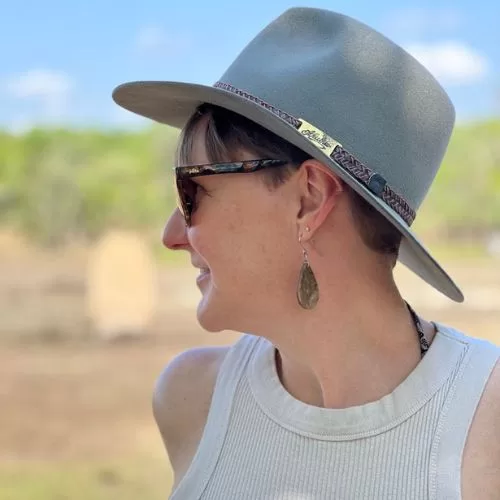
Wendy is a traveller, writer, and photographer with an insatiable curiosity for the world. Her journey, spanning South Africa, the UK, and now Australia, infuses her work with a rich tapestry of experiences. Join her on Getting Lost Again as she shares her creative perspective and passion for overland travel alongside Dan.
